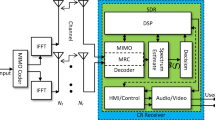Abstract
Cognitive radio (CR) has been proposed and widely investigated as an approach for increasing the spectrum efficiency. CR devices exploit so called white spaces in the spectrum allocated to the primary users (PU) by a process commonly referred to as the spectrum sensing. In this work, we use the singular value decomposition (SVD) for spectrum sensing in orthogonal frequency division multiplexing-based (OFDM) CR systems. A single input multiple output channel is assumed between the PU and the secondary user equipped with multiple antennas. At the CR side, the multitaper method (MTM) is used for the spectrum sensing in each antenna. As a first contribution, we aim at reducing the time necessary to perform spectrum sensing. To this end, we propose an adaptive MTM–SVD spectrum sensing method that decreases the sensing time. As a second contribution, we formulate a three dimensional SVD (referred to as 3-D SVD) scheme that efficiently processes signals and quantities related to multiple antenna traffic, OFDM multiple blocks and different tapers, simultaneously. Simulation results indicate that the proposed adaptive MTM–SVD decreases the sensing time by about 61–69 % for various proposed adaptive algorithms, compared to the conventional MTM–SVD method. Besides, performance improvement in probability of detection is achieved from 2–13 % for a predefined probability of false alarm by using adaptive MTM–SVD. In addition to further reduction of the sensing time, the proposed 3D-MTM–SVD outperforms conventional methods for the low probability of the false alarm.












Similar content being viewed by others
References
Haykin, S. (2005). Cognitive radio: Brain-empowered wireless communications. IEEE Journal on Selected Areas in Communications, 23, 201–220.
Akyildiz, I. F., Lee, W. Y., & Vuran, M. C. (2006). NeXt generation/dynamic spectrum access/cognitive radio wireless networks: A survey. Computer Networks, 50, 2127–2159.
Qing, Zh, & Sadler, B. M. (2007). A survey of dynamic spectrum access. IEEE Signal Processing Magazine, 24(3), 79–89.
Zeng, Y., & Liang, Y. (2010). A review on spectrum sensing for cognitive radio. EURASIP Journal on Advances in Signal Processing, 2010, 2.
Tian, Zh., & Georgios, B. (2006). A wavelet approach to wideband spectrum sensing for cognitive radios. In 1st International conference on cognitive radio oriented wireless networks and communications.
Tumuluru, V. K., Ping, W., & Niyato, D. (2010). A neural network based spectrum prediction scheme for cognitive radio. In IEEE international conference on communications (ICC) (pp. 1–5).
Farhang-Boroujeny, B. (2008). Filter bank spectrum sensing for cognitive radios. IEEE Transactions on Signal Processing, 56(5), 1801–1811.
Farhang-Boroujeny, B. (2010). Spectral estimation in cognitive radios. In S. Haykin & K. J. R. Liu (Eds.), Handbook on array processing and sensor networks, chap. 24. Wiley.
Haykin, S., Thomson, D. J., & Reed, J. H. (2009). Spectrum sensing for cognitive radio. Proceedings of the IEEE, 97(5), 849–877.
Thomson, D. J. (1982). Spectrum estimation and harmonic analysis. Proceedings of the IEEE, 70(9), 1055–1096.
Alghamdi, O. A., & Abu-Rgheff, M. A. (2009). Performance evaluation of cognitive radio spectrum sensing using multitaper-singular value decomposition. In 4th International conference on cognitive radio oriented wireless networks and communications, CROWNCOM (pp. 1–6).
Alghamdi, O. A., & Abu-Rgheff, M. A. (2010). Local MTM-SVD based spectrum sensing in SIMO OFDM cognitive radio under bandwidth constraint. In Proceedings of the 5th international conference on cognitive radio oriented wireless networks and communications (CROWNCOM) (pp. 1–6).
Gruenbacher, D. M., & Hummels, D. R. (1994). A simple algorithm for generating discrete prolate spheroidal sequences. IEEE Transactions on Signal Processing, 42(11), 3276–3278.
Jun, W., & Zhang, Q. T. (2009). A multitaper spectrum based detector for cognitive radio. In Wireless communications and networking conference (WCNC) (pp. 1–5).
Zhang, Q. (2011). Theoretical performance and thresholds of the multitaper method for spectrum sensing. IEEE Transactions on vehicular technology, 60, 5.
Alghamdi, A., & Ahmed, M. (2011). Optimal and suboptimal multi antenna spectrum sensing techniques with master node cooperation for cognitive radio systems. Journal of Communications, 6, 7.
Badeau, R., Richard, G., & David, B. (2004). Sliding window adaptive SVD algorithms. IEEE Transactions on Signal Processing, 52(1), 1–10.
Wen, Y., Chan, S. C., & Ho, K. L. (2003). Robust recursive bi-iteration singular value decomposition (SVD) for subspace tracking and adaptive filtering. In Proceedings of international symposium on circuits and systems, ISCAS (Vol. 4, pp. IV-424- IV-427).
Strobach, B. (1997). Bi-iteration SVD subspace tracking algorithms. IEEE Transaction on Signal Processing, 45, 1222–1240.
Kolda, T., Bader, B. (2008). Tensor decomposition and application. SIAM Review.
Tucker, L. R. (1963). Implications of factor analysis of three-way matrices for measurement of change. In C. W. Harris (Ed.), Problems in measuring change (pp. 122–137). Madison, WI: University of Wisconsin Press.
Tucker, L. R. (1966). Some mathematical notes on three-mode factor analysis. Psychometrika, 31, 279–311.
Mahmoud, H., Yucek, T., & Arslan, H. (2009). OFDM for cognitive radio: Merits and challenges. IEEE Wireless Communications, 16(2), 6–15.
Axell, E., & Larsson, E. G. (2010). Optimal and near-optimal spectrum sensing of OFDM signals in AWGN channels. In 2nd International workshop on cognitive information processing (CIP) (pp. 128–133).
Yan, X., & Rangarajan, S. (2011). Multitaper spectrum sensing of OFDMA signals in frequency selective fading environment. In 6th International ICST conference on cognitive radio oriented wireless networks and communications (CROWNCOM) (pp. 56–60).
Chen, H., & Guizani, M. (2006). Next generation wireless systems and networks. Hoboken, NJ: Willey.
Acknowledgments
This work was supported by Research Institute for Information and Communication Technology under Grant No. \(T/19252/500\).
Author information
Authors and Affiliations
Corresponding author
Rights and permissions
About this article
Cite this article
Rezaei, F., Torkamani-Azar, F. & Sadough, S.M.S. An Adaptive Multitaper-SVD Spectrum Sensing Method for OFDM-Based Cognitive Radio Systems. Wireless Pers Commun 79, 831–846 (2014). https://doi.org/10.1007/s11277-014-1889-6
Published:
Issue Date:
DOI: https://doi.org/10.1007/s11277-014-1889-6




